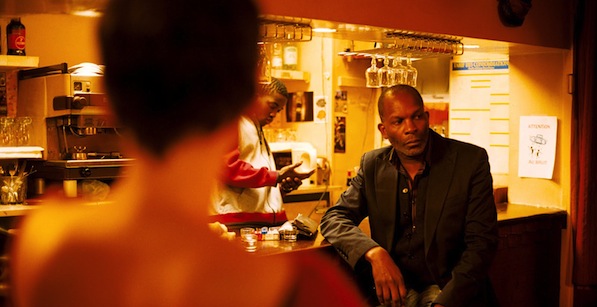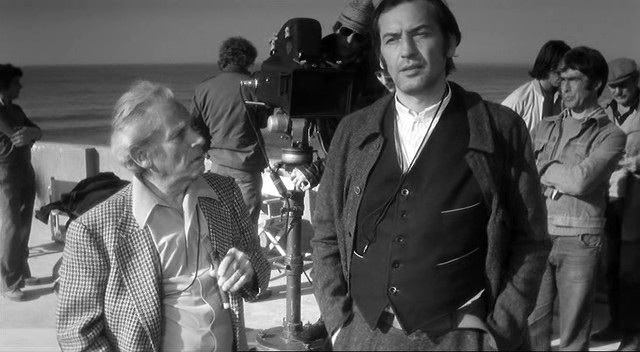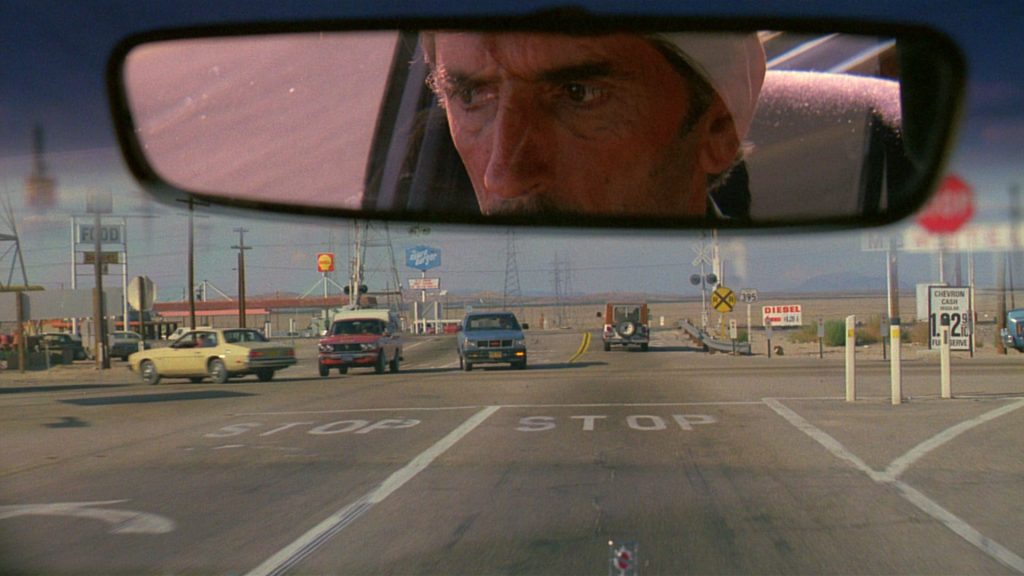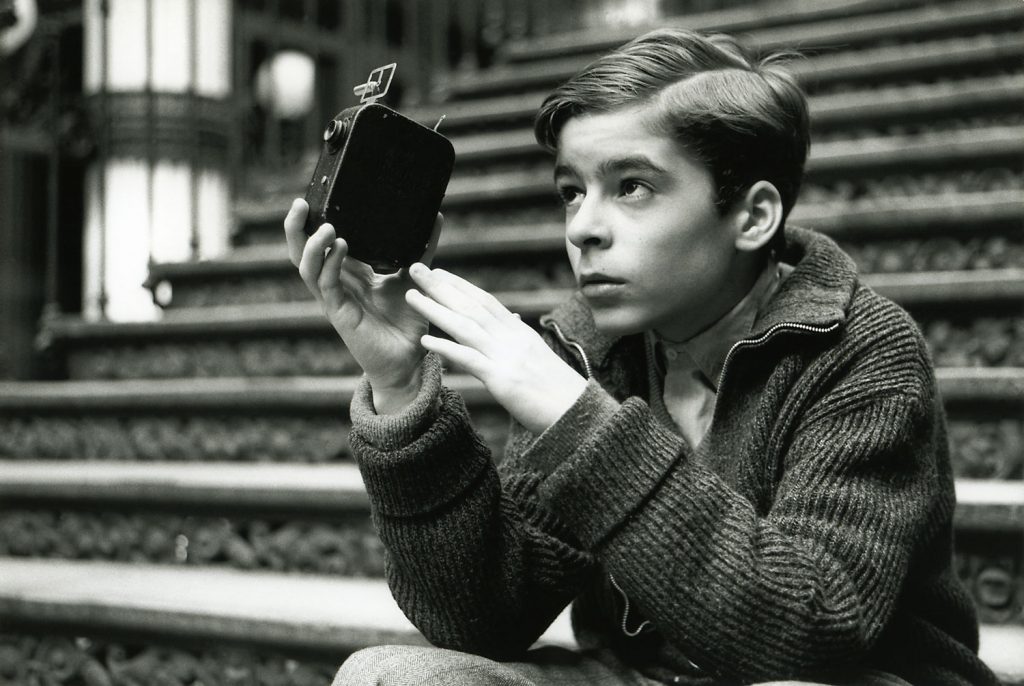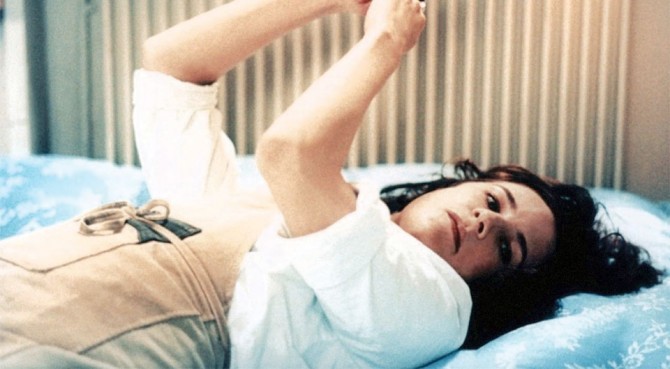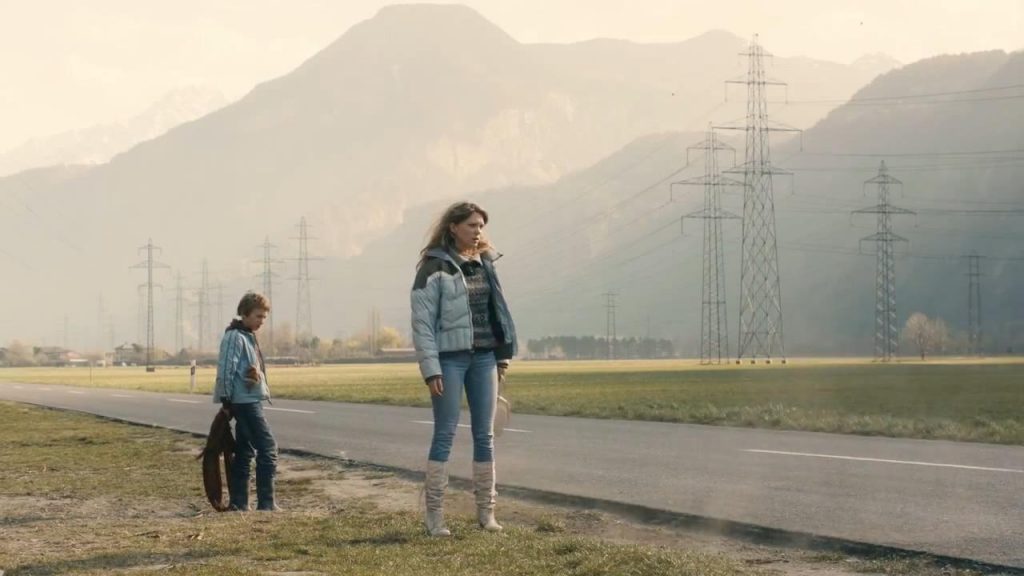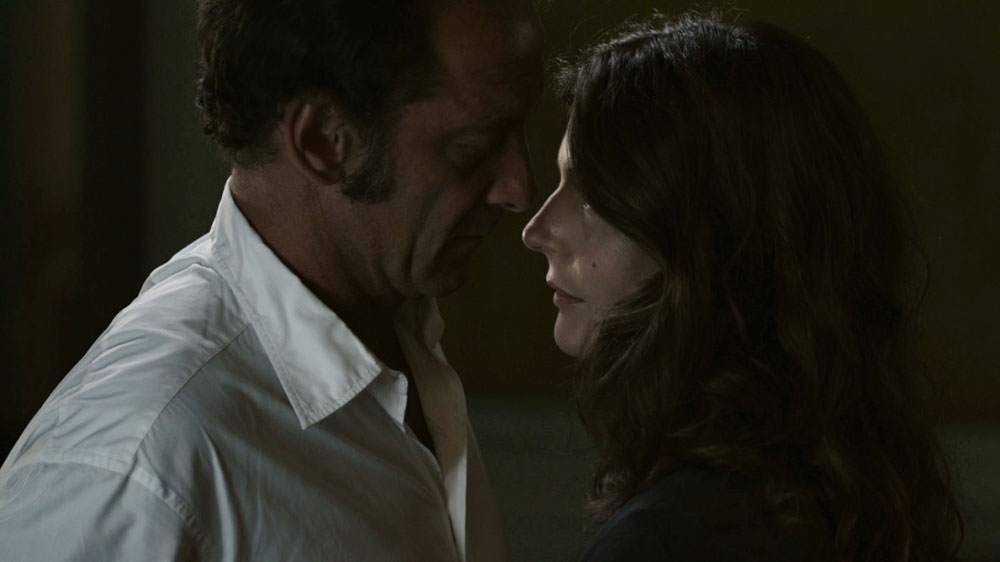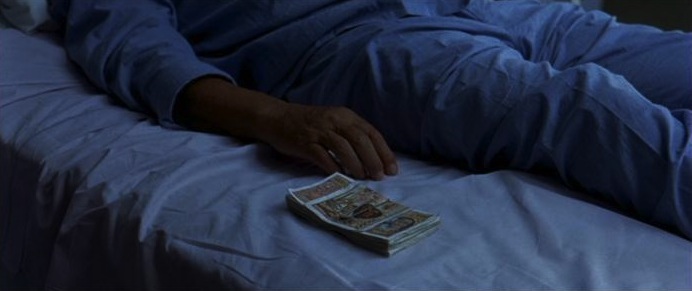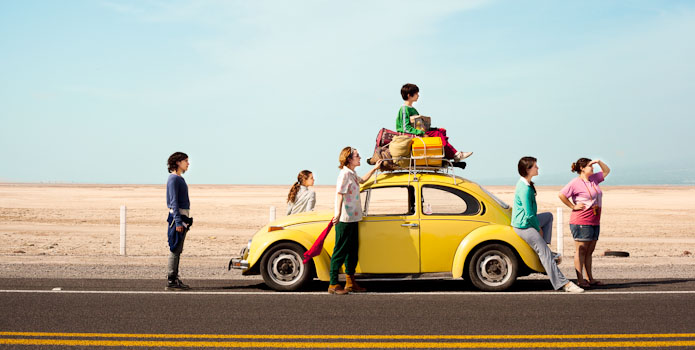As a companion piece to a pair of Claire Denis interviews (old and new), Fandor co-founder Jonathan Marlow capitalized on the opportunity of an appearance at the Pacific Film Archive in June to interview the extraordinary cinematographer Agnès Godard.
The latest collaboration between Agnès Godard and Claire Denis—Bastards—opened in New York this week and will be screening elsewhere over the weeks ahead while TIFF Cinematheque continues its celebration of the career of Claire Denis.
Jonathan Marlow: I want to go back. All the way back to the beginning. You have photographed several of my very favorite films. You are an immensely talented collaborator, it seems, given the assortment of filmmakers with whom you’ve worked and the fact that the ‘look’ of all of your work is always in the service of the respective film. Going back to The State of Things and your work with Wim Wenders, how did that association come about? What was your path from camera operator to cinematographer? Because it wasn’t part of your original plan….
Agnès Godard: It was not original plan because I did not dare to think like that. I was very shy. I was just very lucky to be asked by Henri Alekan to work with him on The State of Things. I met Henri when I was a student in the cinema school. In the last year, you have to do your own film to complete your studies. But , in the meantime, I had to do the lightning on the several films at the cinema school, IDHEC [L’Institut des hautes études cinématographiques]. We were allowed to have a guest teacher sometimes. One guy from my class asked me to do the lighting and he asked Henri Alekan to be the teacher for two days. So I worked with Henri at that time. Several months later, I completed my studies but I was too shy to call anybody. And then one day Henri Alekan called me. He said, ‘You know what? I’ve been traveling in Portugal with Raúl Ruiz and I met a guy named Wim Wenders. He’s going to make a film. I thought about asking you to be my assistant.’
Marlow: Right. The beginning of The State of Things was shot partially on the set of the Ruiz film The Territory, yes?
Godard: Not on the set….
Marlow: But some of the same cast and crew.
Godard: Let’s say that they borrowed some of each.
Marlow: Yes. [Laughs.]
Godard: And that’s how I became Henri’s camera assistant. It was incredible because I had never worked before. I just trained for two days. I said to Henri, ‘But this is really risky, because…’ He said, ‘That doesn’t matter. I’m the only one who knows. It’s going to be okay.’ And that’s how I started. After that, Wim asked me to work on Paris, Texas and then he called Henri again for Wings of Desire. Henri said, ‘Okay. I’m going to come but, this time, Godard will operate the camera.’ And Wim said, ‘Okay.’ And that’s it.
Marlow: When you were the camera operator on The State of Things, the end [spoiler] takes place in the U.S. Were you involved in that part of the shoot?
Godard: No. I wasn’t part of the U.S.
Marlow: So the first occasion was for Paris, Texas?
Godard: Yes, exactly. I worked only on the Portuguese portion of The State of Things… Which was the longest part of the film.
Marlow: The first on which you’re credited as cinematographer was the short that Wenders shot at Cannes, correct? Room 666?
Godard: Yes. You can say that. Though I don’t quite remember if I worked first on a documentary also with Claire [Denis], Jacques Rivette: Le veilleur.
Marlow: Correct, for television. Part of Cinema of Our Time.
Godard: I worked on a Peter Handke film [The Absence] as well. I think it was the first.
Marlow: Or roughly the same time?
Godard: Or Jacquot de Nantes [directed by Agnès Varda]. I don’t remember in which order.
Marlow: During the experience of working with Wim Wenders, is that where you first met Claire Denis?
Godard: No. I knew her before. I had met her before. As a matter of fact, I discovered that she was going to work on Paris, Texas and I was also going there to work. But I met her when I was still studying at the cinema school.
Marlow: I see.
Godard: After cinema school, I directed a short film. So naturally, when my film was finished, I invited her to see the film. I went to see her to ask for her advice. That was just before Paris, Texas was shooting. While we were shooting Paris, Texas, she said, ‘If I direct a film, would you like to work with me?’ We met again on Wings of Desire. She just directed Chocolat after that.
Marlow: She had Chocolat already planned at that point.
Godard: Yes. The script was ready… On Chocolat, I was not doing the lighting. I was operating.
Marlow: As the camera operator.
Godard: Because the producer didn’t agree with the idea that I could be the DP of the film since I had done nothing before.
Marlow: That has obviously changed considerably now. You’ve worked with an assortment of great filmmakers over the last three decades. Amongst a new generation of directors, you photographed Home and Sister. How did you meet Ursula Meier?
Godard: I had been contacted by the production. The production called me and sent me a script. I read the script right away and I just had a ‘coup de froid.’ How do you say that in English?
Marlow: I’m not sure. A chill?
Godard: Coup de froid. I fell in love with the script. I called the production and I said, ‘Yes, yes. This script is really fantastic. I would like to meet her.’ We met, I think, ten days later. She was traveling at that moment. We had an appointment in a cafe and we didn’t pay attention. We were talking and talking and talking. When it was time to leave we realized that we’ve been talking for five hours! [Laughs.]
Marlow: It was meant to be.
Godard: Yes. I am amazed by her capacity to invent stories, to create worlds and characters, to make it work. It seems to be so easy for her. It’s like it is autobiographic but it is not. It is incredible. She’s looking for something that belongs to cinema. I don’t know. It’s like an invitation to me, for me to do that with her. It’s… I don’t how to describe it another way. She’s younger than me. She could be my daughter. But it… she’s very strong. She works a lot. She thinks a lot. She’s passionate. It’s a pleasure to work with her.
Marlow: With your cinematography, you tend not to do anything that is extraneous or showy. You’re not trying to say, ‘Look at this beautiful image.’ [Though the films are full of beautiful images.] At the same time—with something like Friday Night—you can communicate so much of the inner lives of the characters in the way in which you collaborate with the director—in this case, Claire Denis—with the performances and the mise‑en‑scène and what you’re doing with the camera evokes characteristics of the story that aren’t necessarily inherent but wouldn’t be as evocative in the hands of a different DP. From your recent work on Sister, where you’re shooting digitally for the first time, to Claire Denis’ latest film, Bastards, which I saw at Cannes… on the surface, these two films could’ve been shot by completely different people and yet the aesthetics seems very similar. The lightness of the former and darkness of the latter are on very different spectrums and yet you’re doing something very similar, working very closely with what the script demands or what the story demands. I don’t think there are enough cinematographers that do that as well as you.
Godard: Thank you. Thank you. It’s very pleasant to hear that because my conception of this job is to be a companion or a collaborator. It’s to complete something. It is also making the image as separate from the directing but to be part of the storytelling process. If you have some distance with the film you are watching, you’ll be just attracted. You’ll be swimming in it. [Laughs]. Or enveloped, like music….
Marlow: Correct, yes.
Godard: It’s like being close to people. The only difference is that you can’t touch. But that is the sense of an image. I think that cinema is working upon a concept of mystery and curiosity. Mystery creates curiosity. Curiosity attracts you. When I look through the camera, filming someone, what I’d like to be able to see is what is in his mind. Not only to look at him.
Marlow: Right. I think it is the same characteristic that you see in a great painting. It doesn’t merely represent what it is. It represents all that it can be.
Godard: Yes. And I think that is why I do not like aesthetic images too much. For me, an image that is accomplished is an image where you see more of the thought than the gesture of making the image.
Marlow: And that’s a very different way of working from what is typical in this country. Obviously, your sense of collaboration is fulfilling and rewarding or else, when you made your short, you may have decided to become a director. What was the title of your short film, by the way?
Godard: The Light Under the Door.
Marlow: What became of this film? Is it on a shelf somewhere?
Godard: Yes! It’s in my room.
Marlow: I was afraid of that. Bastards shares a certain stylistic and structural connection with The Intruder. You’re doing something that shares common aspects of contemporary literature yet does not occur often—if at all—in film. The ability to take fragments and suggest a larger story that is much more expansive than the duration of the film would allow. That is really remarkable. To arrive at this point, I do not know if it would be possible if you and Claire Denis did not have an extensive working relationship. I presumed that there are some intuitive elements….
Godard: Yes.
Marlow: …in working that other teams of filmmakers couldn’t even begin to approach. Maybe I’m naïve, but….
Godard: No. You just used this word, ‘intuitive.’ I think it is something. The school I went through was more a directing school. So I never considered myself as an accomplished technical person, technician. But I was more interested about the question, ‘What can we do with an image?’ In a way, I’ve been leaning on intuition even though I was scared about it. But I just sort of accepted and even found pleasure in it. So you’re right. It’s a part of intuition. Then, sometimes, I would discover something working together with Claire. It was like an exchange. Sometimes she will give me the viewfinder and I will have a look. It was like that because we were exchanging ideas. I was totally confident about her writing her project and she was probably confident in the way I could make suggestions. I would say, maybe, ‘Let’s do that.’ ‘No, only a close‑up.’ For me, that’s enough. You see what I mean?
Marlow: Yes.
Godard: It’s been different with Ursula because she’s not so elliptical. But I feel we are developing something, also. Ursula will never make exactly the same kind of film that Claire does.
Marlow: No, of course not.
Godard: That’s for sure. But I find a way to work with Ursula….
Marlow: Right. Well, you have a way to work with everyone. It seems as if you’ve been fairly selective in the projects that you have decided to become involved with. That level of selectivity has certainly helped in allowing you to work in the way that you’ve wanted to work. I mean, there aren’t projects in your filmography that suggest, ‘Well, you know… I did that because I just needed to do something.’ Everything seems to serve a purpose….
Godard: Yes, you’re right. That’s why I started to develop my personal work. It’s not film but it’s images. Because it is a passion. I’m chipper. I think I’m looking for one image. I’d like to find one. [Laughs.] One is enough, if it’s the right one. I think it’s incredible. You don’t know if it’s new or if it was 5,000 years old. It represents existence, the mystery of being alive. Look at a picture, for instance, a family picture. Somebody will look at the camera. So, fifty years later, you look at the picture and the guy looks like you. It’s virtually a bit crazy, no? It is like infinite research.
Marlow: Was the foundation still photography? This was something that was deeply attractive to you?
Godard: Yes. Probably, because my father used to do a lot of family pictures. He didn’t talk much. He was a bit reserved. You say that? When he died, a long, long time ago, I discovered that his thousands and thousands of pictures were his way to communicate with us, his family. It’s something.
Marlow: Something came out of looking at those photographs again?
Godard: Yes. When I was a little girl, I was looking at him taking pictures. That’s how it was. It’s very simple. No, it’s true. It’s very true. But family pictures, you know, it is very… Maybe that’s what I’m looking for. You do a picture for one reason, at one point. There is no business in a family picture.
Marlow: Right. It is a frozen moment in time.
Godard: It’s a one time and one thing. I think, somehow, it’s the first time and the last time of this moment. I think, somehow, that some of what I’m looking for since I’ve been working doing images is to find this sensation. First time, last time, in the meantime. It is one unique moment.
Marlow: That is the sensation your work evokes in Bastards. The order of those moments seems somewhat fluid but you’re playing a lot with the way in which images can manipulate people. How they can convince audiences of things that may or may not be real. I think it’s an amazing piece of work. Initially, I hadn’t realized that you were working with Ursula Meier until I discovered your name in the credits. If I see your name, I know that the film is going to be worth my time and attention. Like Ursula, are there other younger filmmakers that you feel a desire to work with?
Godard: Yes. I like to work! Last year I worked in Mexico with a young woman [Claudia Saint-Luce’s Los insólitos peces gato]. I really like to work with young people because they often have different references. They have their reference. I have mine. We mix everything together and it’s really active. It’s happiness. It’s curiosity. It’s also a way to keep on searching. When you work, you start all over again each time.
Marlow: Right, yes.
Godard: It’s the best way to stay alive.

